SEO has a lot of buzzwords, but one you might not hear that often is link velocity—and it's a concept worth paying attention to.
Now, we know it sounds a bit technical, but after reading this post, you’ll see it’s actually pretty simple and can bring so many benefits for your site.
Link velocity is the pace at which your website picks up backlinks over time.
If you're getting links too fast, it could raise some red flags with Google, kind of like speeding through a school zone. On the other hand, if your link growth is crawling, you might not get the momentum you need to stay competitive.
It’s all about finding the right balance—growing at a pace that feels natural and sustainable.
Nail this, and you’re setting your site up for long-term success.
What Is Link Velocity?
In plain terms, link velocity is about how fast or slow your site gains backlinks.
You shouldn’t simply aim to collect as many links as possible; doing it in a way that looks organic and keeps you on the good side of Google is what really matters.
Here at Editorial.Link, we’ve noticed how crucial it is to strike the right balance.
If you start collecting backlinks too fast, it might look like you’re trying to cheat the system, which can raise some eyebrows with Google.
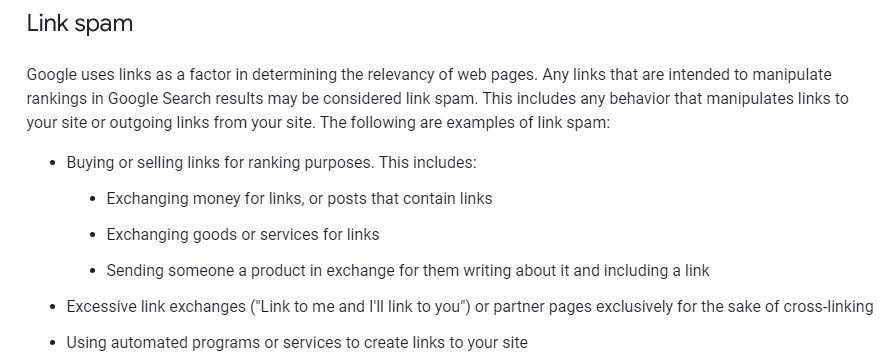
On the other hand, if you’re moving too slow, you might find yourself lagging behind competitors who are zipping ahead.
Here’s our backlink profile as seen by Ahrefs:
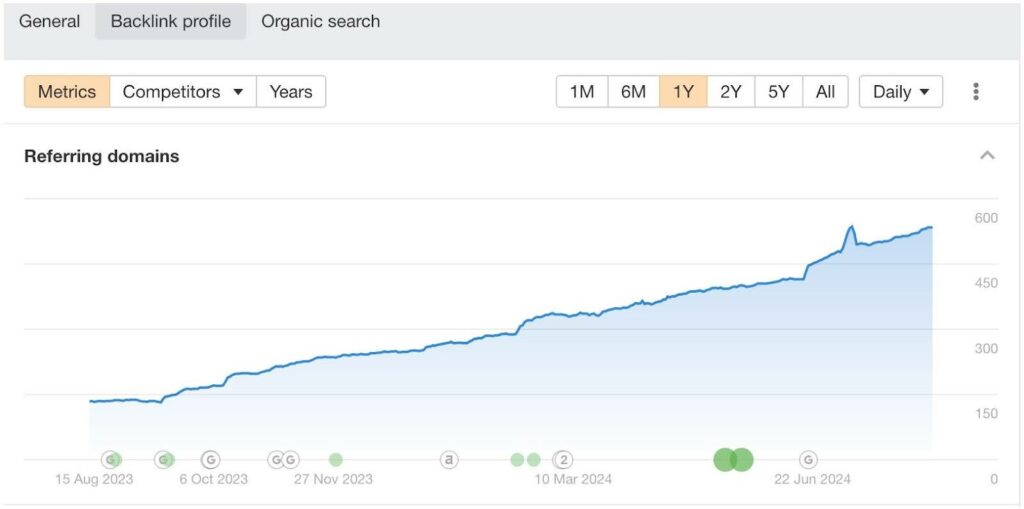
You see how it’s growing? That’s because we’re doing it right! And we’re getting stronger.
By the way, 64.6% of 113 SEO experts from our latest survey consider Ahrefs the best all-in-one SEO tool.
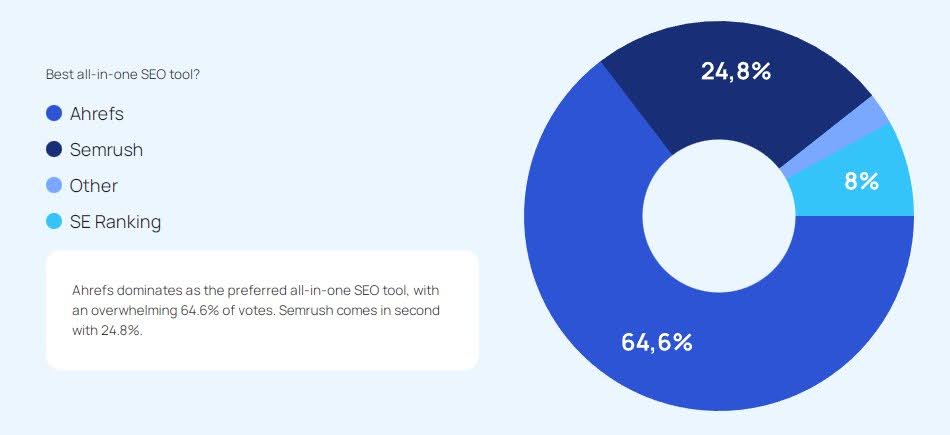
So basically, it’s not just about how fast you can go; it’s about building momentum at a steady, natural pace.
Picture this: one of your blog posts goes viral, and suddenly, everyone’s linking to it. That’s awesome—and totally fine—because those links are coming from real people who genuinely find your content valuable.
Fact: Google’s more interested in the quality and relevance of your backlinks than how fast you’re collecting them.

By the way, according to our survey, link relevance is the number one metric used to measure the quality of a backlink.
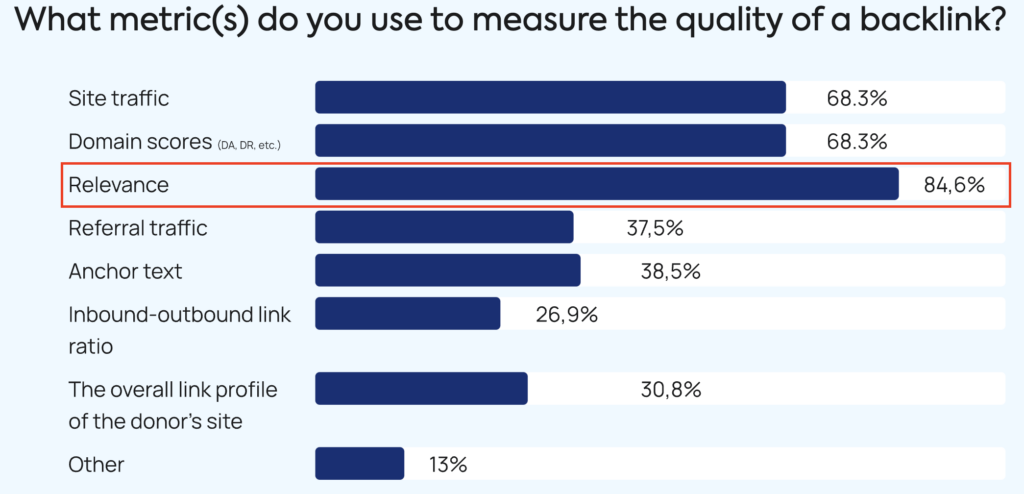
If you’re playing fair and letting your links grow naturally, you’re on the right track. But if you’re trying to game the system by buying links or using shady tactics instead of white-hat link building methods, that’s where you might hit a snag.
In a nutshell, link velocity is about growing your site’s backlink profile in a way that looks natural and healthy. It’s a key piece of the puzzle when it comes to keeping your SEO strategy on point and staying ahead in the game.
Is link velocity important for SEO?
Yes, link velocity definitely matters for your SEO. Some might argue it’s not a big deal, but it does play a part.
Even if it’s not a direct ranking factor, how quickly your site gains backlinks can affect how Google views your site’s credibility.
That’s why it’s worth monitoring your backlink growth. It helps you tweak your strategy and build trust with Google over time.
Will a Higher Link Velocity Lead to a Higher Google Ranking?
The short answer? No, it won’t.
Link velocity, by itself, isn’t a ranking factor. But that doesn’t mean it’s irrelevant. The way your link profile grows can still have a big impact on your site’s performance—both good and bad.
Here’s the deal: if your backlink growth is natural and comes from credible, authoritative sites, it can definitely boost your site’s reputation.
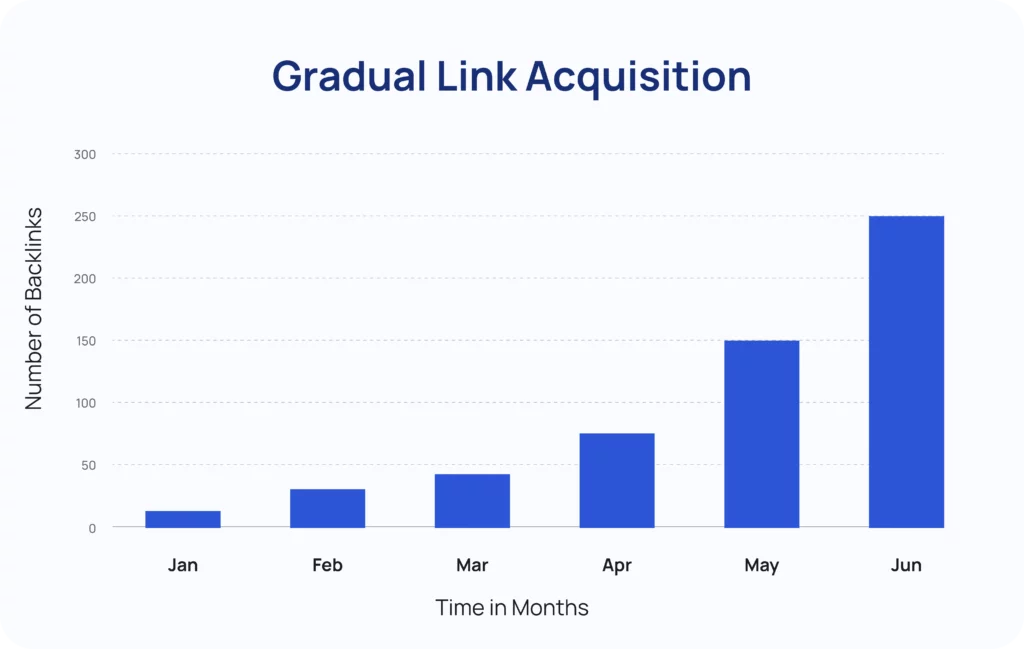
However, if you’re using black-hat tactics like link farms or spamming, you’re setting yourself up for trouble. Google’s algorithms are pretty sharp, and they can spot unnatural link patterns a mile away.
Over-optimizing your link-building efforts by going for quantity over quality can backfire. Not only might you face penalties that hurt your rankings, but you’ll also waste time and money on links that won’t do much for your long-term success.
So, while a higher link velocity won’t directly push you up the rankings, the way you go about building those links can definitely influence where you land.
How to check link velocity for a website or page?
If you’re wondering about how to check your site’s link velocity and want to see how your backlink profile is shaping up, Ahrefs’ Site Explorer is a great tool to get the job done.
The whole sequence of steps is pretty straightforward, even if you’re not a data whiz.
Here’s how you can do it:
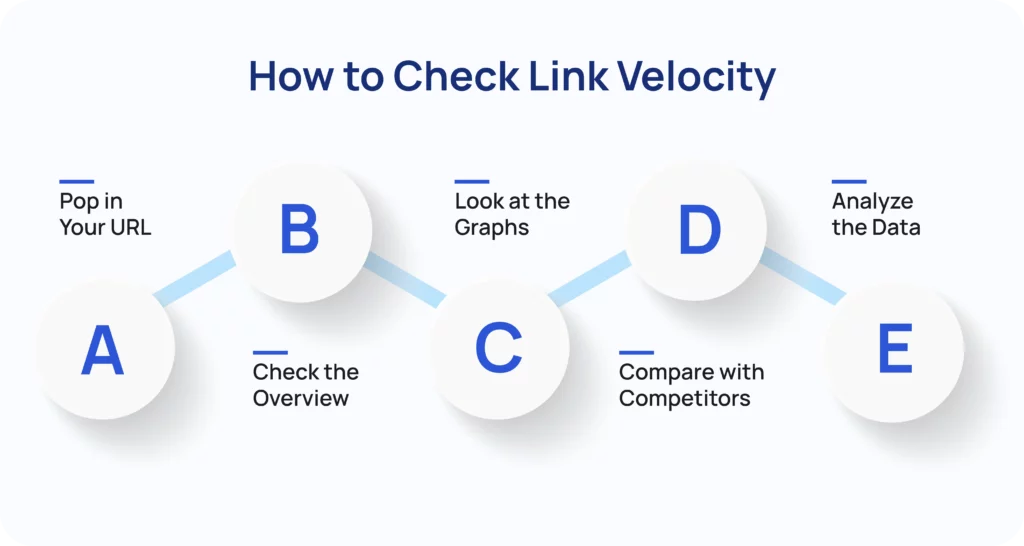
Pop in your URL
First, head over to Ahrefs and open up their Site Explorer. Just paste your website’s URL (or a specific page) into the search bar and hit enter. You’ll want to select the ‘URL’ option if you’re checking a single page.
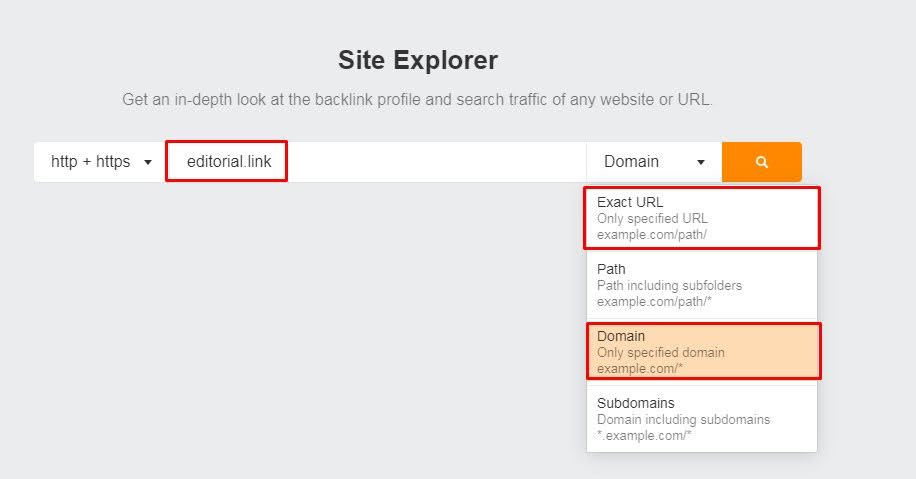
Check the overview
Right off the bat, you’ll see an overview that shows how many backlinks and referring domains are pointing to your site/page.

This is where you can start to get a feel for your link velocity.
Look at the graphs
Scroll down a bit, and you’ll find graphs that track the growth of referring domains over time. This visual gives you a snapshot of how your backlink profile has evolved.
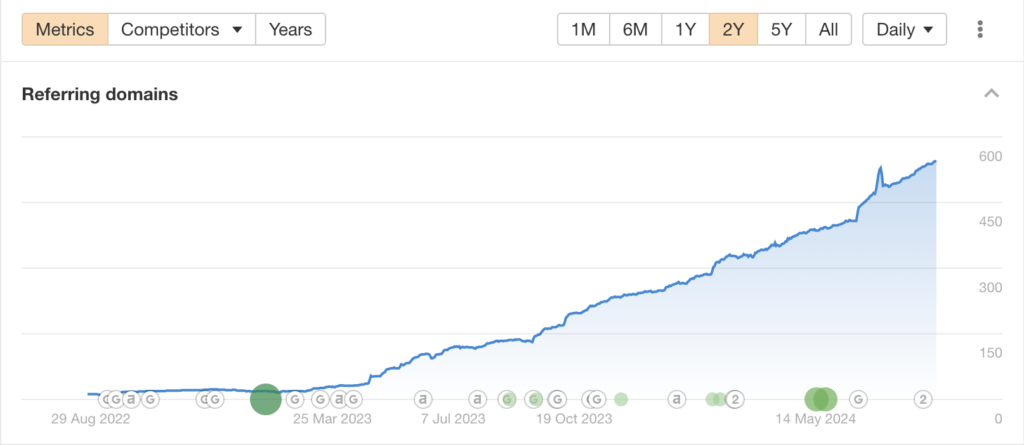
Keep in mind that you’re looking for steady, consistent growth—nothing too wild or erratic.
Compare with competitors
Want to see how you stack up against the competition?
Click on the ‘Competitors’ tab in the performance graph.

Here, you can paste in a competitor’s URL and see how their link velocity compares to yours.
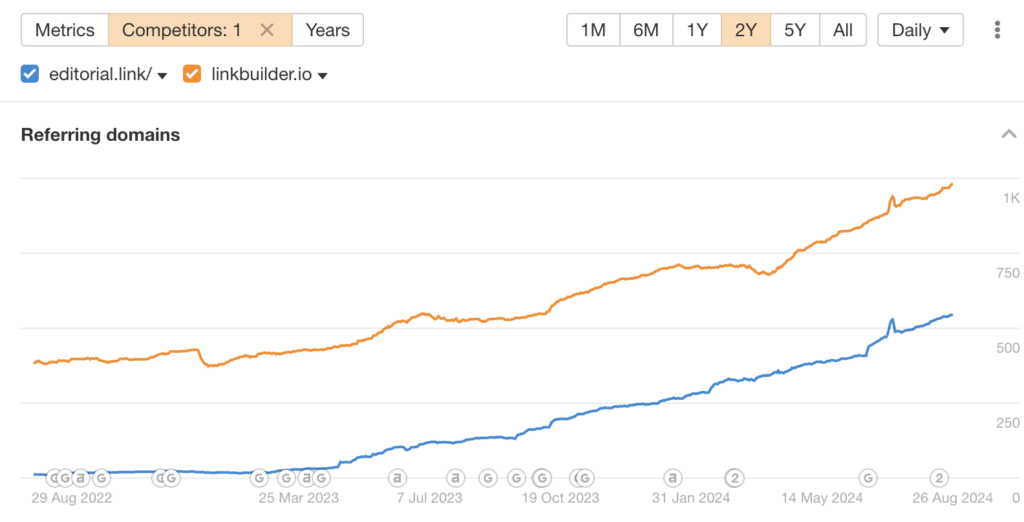
Analyze the data
Finally, take a close look at the trends.
A sudden spike in backlinks might be a red flag, especially if it doesn’t align with a specific event like a viral post. On the other hand, a gradual, consistent increase is what you’re aiming for.
This way, you can keep tabs on your link velocity and make sure your backlink profile is growing in a healthy, natural way.
Should You Monitor Your Link Velocity?
So, do you really need to keep an eye on your link velocity?
Well, it’s 50/50.
A lot of companies don’t obsess over it, and that’s perfectly fine. But tracking link velocity can give you some valuable insights.
Monitoring link velocity is also essential to safeguard your site against negative SEO attacks. These occur when spammy backlinks are deliberately created to harm your rankings. While Google claims to identify and neutralize such tactics, it’s still wise to keep an eye on any unusual backlink activity.
Google seems to use metrics like link velocity spikes—the rate at which spam links accumulate—to detect and mitigate these threats. It evaluates factors like:
- When spammy links were acquired;
- The average number of spam links per day;
- Abrupt surges in low-quality backlinks.
Patterns in anchor text manipulation, such as an influx of identical or irrelevant anchor texts, also raise red flags. By identifying these issues early, you can address potential problems and maintain your site’s credibility.
While Google’s tools aim to neutralize harmful backlinks during such attacks, regular monitoring ensures you can quickly identify and resolve any vulnerabilities in your backlink profile.
Here’s the thing: while link velocity itself isn’t a magic bullet for getting to the top of Google’s search results, it’s still a useful metric to monitor. It can help you see how well your SEO efforts are paying off and whether your backlink strategy is on the right track.
Think of it as one piece of the bigger puzzle.
Just like you’d keep an eye on your site’s Domain Rating (DR) or traffic stats, checking in on your link velocity can help you gauge your competitiveness. It’s especially handy when you want to see how your site’s growth compares to your competitors.
Tools like Ahrefs or Semrush can make this process easier by offering detailed stats on your backlink profile. You can see where your links are coming from, how they’re performing, and even find new opportunities for guest posting that align with your strategy.
All in all, while monitoring link velocity isn’t mandatory, it’s definitely something to consider if you want to stay ahead of the curve.
How to Boost Link Velocity Without Risks
Want to ramp up your link velocity without getting on Google’s bad side? It’s definitely doable, as long as you’re smart about it.
Once again, the goal is to grow your backlink profile naturally.
Here’s your plan to follow:
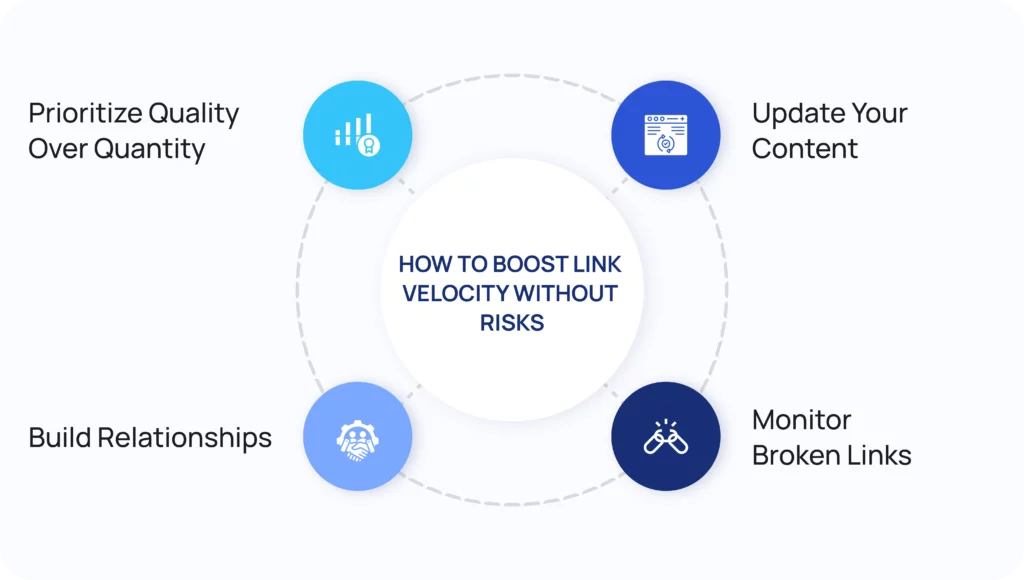
Prioritize quality over quantity
When it comes to backlinks, a few solid, high-authority links from reputable sites will do way more for your SEO than a bunch of low-quality ones.
And even though 54% of experts from our survey build between five and twenty high-quality backlinks per month, focusing on quality over quantity and speed is the way to go.
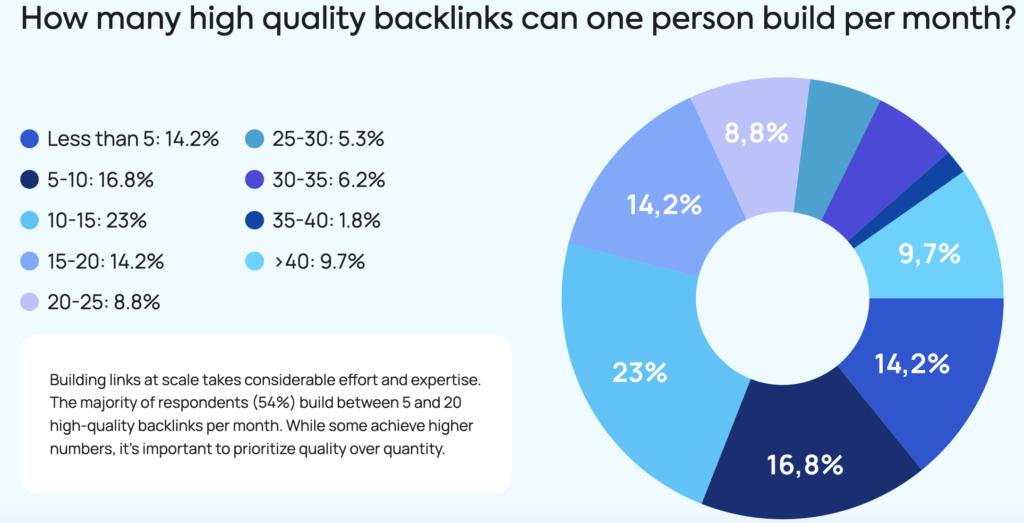
So, focus on getting links from relevant sites that really matter in your industry.
Update your content
Fresh content is like a magnet for backlinks.
By updating your existing content, making it more comprehensive, and adding new insights, you’re giving people more good reasons to link to it.
Plus, Google loves fresh content, so it’s a win-win.
Monitor broken links
Here’s a simple trick: keep an eye out for broken links on other sites.
When you spot one, reach out and suggest your content as a replacement. It’s a low-risk strategy that not only helps the site owner but also earns you a valuable backlink.
Build relationships
Building strong connections that count is key.
Whether it’s with other website owners, bloggers, or influencers in your niche, these connections can lead to natural link-building opportunities.
Think guest posts, collaborations, or even just a mention in a roundup post. The more you engage with others in your industry, the more opportunities you’ll have to grow your backlinks in an organic way.
Wrapping Up
At Editorial.Link, we’re all about helping you build links naturally, so your link velocity stays on point. We focus on strategies that keep your backlink profile growing steadily, without any of the risks that come with trying to game the system.
Remember, it’s not just about how fast you can collect backlinks—it’s about doing it in a way that Google recognizes as genuine. With the right approach, you can boost your link velocity and see real, long-term success in your SEO efforts.

